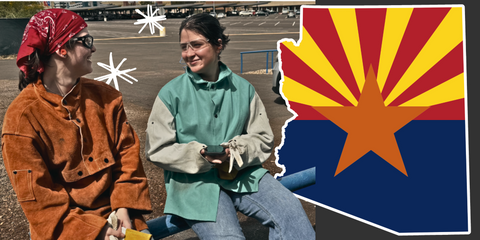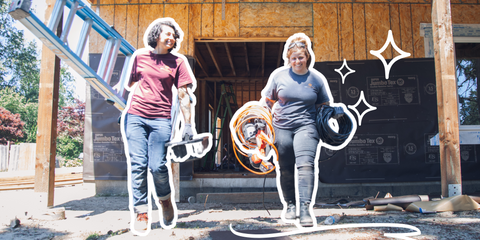Despite COVID-19, the New Zealand construction industry is booming and will continue to experience high growth. At a time when several large government projects have been announced, New Zealand needs skilled construction workers and tradies, but little attempt has been made to recruit women into the industry until recently. However, industry groups such as the National Association of Women in Construction (NAWIC), the Building and Construction Industry Training Organisation (BCITO), and Women in Trades are trying hard to increase the number of women in construction and trades.
NZ Construction Industry

New Zealand has a thriving construction industry that employs over 184 million people and contributed more than $15 million to the New Zealand economy in 2019.
There is very high demand for construction works, both from housing shortages in Auckland and Wellington and large projects, such as:
- Canterbury and Christchurch earthquake rebuilds and Wellington earthquake strengthening
- The $12 billion New Zealand Upgrade Programme, which will fund infrastructure upgrades, especially roading and rail.
- The KiwiBuild programme and 8,000 new state houses
However, the industry has suffered from COVID-19, with Fletcher Building, one of NZ’s largest construction companies, letting go 1,000 employees and making a $55 million loss in April.

The government plans to work with the construction industry to deal with issues such as the collapse of Fletcher Building and other companies, concerns about quality of new builds and the shortage of skilled workers. Several initiatives have been announced, such as:
- 3 billion dollars for infrastructure in the 2020 Budget, including funding for “shovel-ready projects”, projects that are ready to build with a value of over $10 million.
- $1.6 billion Trades and Apprenticeship Training Package
Unfortunately, this spending and growth won’t benefit women as much as it should because of the low participation of women in the construction industry.
Women in Construction in New Zealand
Currently, only 3% of construction employees in New Zealand are women. (The 12% in trades is little better). In New Zealand, as elsewhere, women are taught that, if they want to go into a trade, they should go into something feminine like beauty or hairdressing.
This harmful stereotype leads to discrimination within the industry as well as stopping women from going into trades, as Erica Cummings, BCITO’s advocate for women, points out:
"Research shows us that some employers were advertising by word of mouth and women aren't getting to hear about those opportunities. The other part is that women just don't know that they could work in those areas - [including] the range of trades."
The same research, commissioned by groups in the trades sector, found that only 17% of male employers would hire women tradies.
This attitude needs to change—especially when the massive grant for new apprenticeships makes now the ideal time to increase the number of women in construction in New Zealand. Moreover, construction, which is male-dominated, is likely to be a good source of jobs post-COVID (32,000 in the next few years in Auckland alone). As women make up 90% of New Zealanders let go during the pandemic, (hard-hit industries such as hospitality are female-dominated), they desperately need to get some of these new construction jobs.
It’s not just job security: women who do an apprenticeship in New Zealand earn $145,000 more by the age of 30 than their university educated counterparts. Fortunately, there are plenty of groups inside the industry who are trying to increase female participation in construction.
Construction and Trade Organisations Advocating for Women
Vital to increasing recruitment of women in construction and trades are organisations who provide recruitment events and information to women considering a career in the trades. The interest in recruiting women to trades is high, and there are many organisations who are committed to increasing the number of women in trades and construction in New Zealand, such as:
- The National Association of Women in Construction (NAWIC) is an organisation that encourages women into the construction industry, and provides support and professional development opportunities. Together with BCITO, they run the NAWIC excellence awards to recognise outstanding women in construction.
- The Building and Construction Industry Training Organisation, BCITO, is NZ’s largest construction industry training provider. BCITO has the goals of having 10% of BCITO apprentices women in 2025 and 30% of construction roles filled by women by 2050. (Women currently make up 3% of BCITO’s apprentices).
- Women in Trades is the main organisation representing women in trades in New Zealand. They aim to promote women entering trades through events and working with training partners and other trades organisations.
- The Skills Organisation, a trades training provider, is also actively trying to get more women into trades roles, and showing off positive female role models in trades.
- Māori Pasifika Trades Training is an organisation that offers scholarships to Māori and Pasifika who want to go into the trades industry and encourages Māori and Pasifika women to go into trades and construction.
- #BuildAuckland is an initiative to get more young Aucklanders into Auckland’s busy construction industry. They are particularly interested in attracting more Māori and Pasifika and women to the industry.
New Zealand women are interested in going into construction and trades when they know that this is an option for them. Women who are already in trades cite having family in trades, wanting to do something different and avoiding student loans as reasons for taking this career path. Hopefully, with current effort from the New Zealand construction industry to increase diversity, we will see more women looking at construction and the trades as a viable career option, something the New Zealand construction industry desperately needs.









